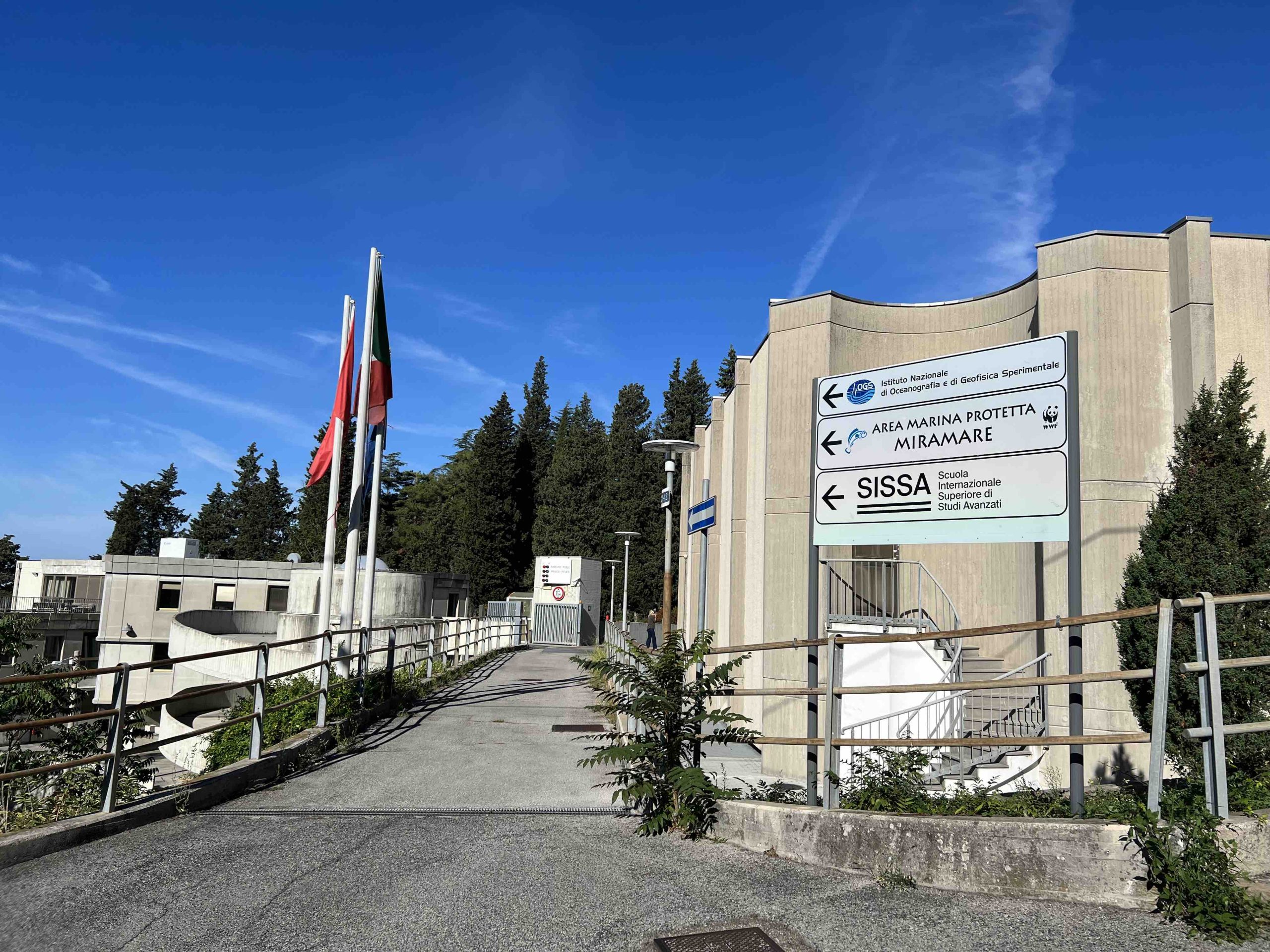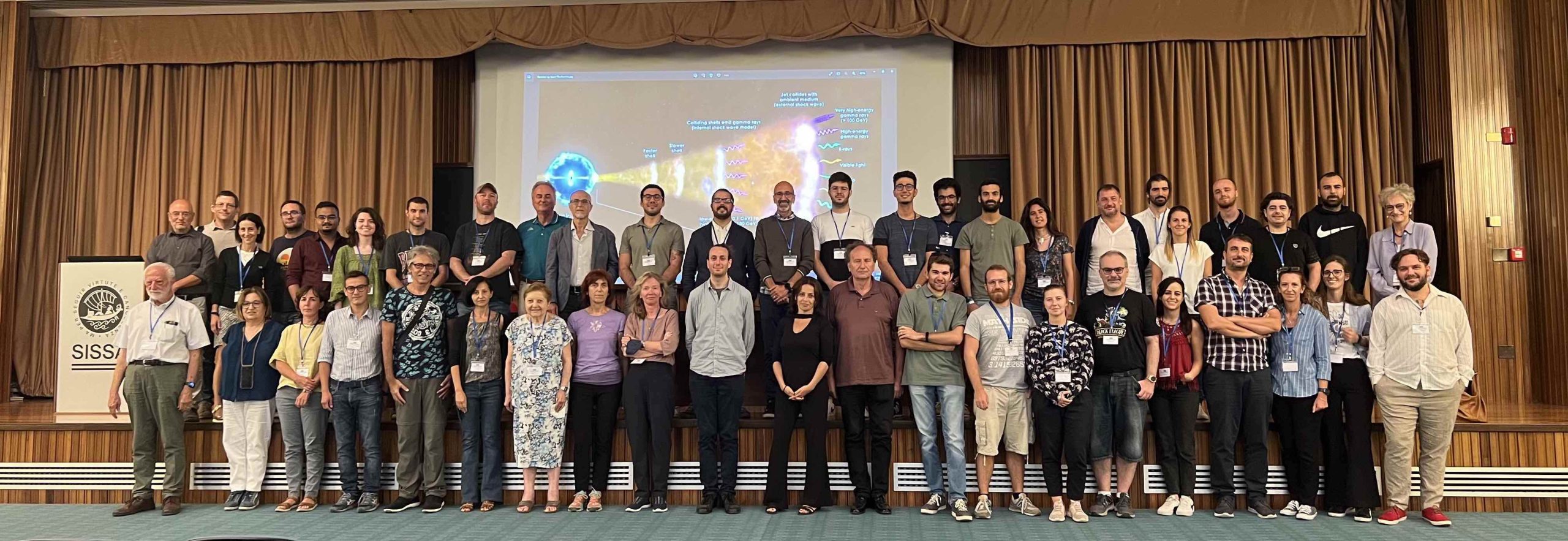
ABOUT
V Congresso Nazionale GRB
12-15 settembre 2022
Il congresso, nel venticinquennale della scoperta degli afterglow da parte di BeppoSAX, vuole essere un'occasione per discutere i recenti sviluppi nel campo dei GRB, soprattutto a seguito della scoperta di emissione ad altissime energie e della connessione degli short GRB con le sorgenti di onde gravitazionali, in vista delle future missioni dedicate ai GRB.
Saranno previste sessioni dedicate a discussioni su questi hot topics:
- Emissione al GeV dei GRB prompt o afterglow?
- Qual è l'origine della Plateau emission?
- E' meglio un sistema di detection Distribuito o Concentrato (sistema di satelliti o un satellite solo?) per il prompt?
- Quali strumenti sono essenziali per le altre fasi dei GRB?
- Quale l'origine della relazione di Amati?
- Motore centrale: magnetar o buco nero?
- Il getto: strutturato o no?
- Il getto: magnetico o cinetico?
- Quale l'origine dell'emissione a basse energie del prompt? Black body o Sincrotrone?
- Che relazione tra i GRB e altri fenomeni transienti?
- Emissione al TeV: SSC o sincrotrone?
Programma scientifico
Il congresso accoglierà inoltre al solito contributi teorici ed osservativi su temi tipici del settore legato ai GRB:
Dissecting the interstellar medium of a z=6.3 galaxy. X-shooter spectroscopy and HST imaging of the afterglow and environment of the Swift GRB 210905A.
Time Evolving Photoionisation Device (TEPID): a new code for time evolving photoionisation and spectral fitting.
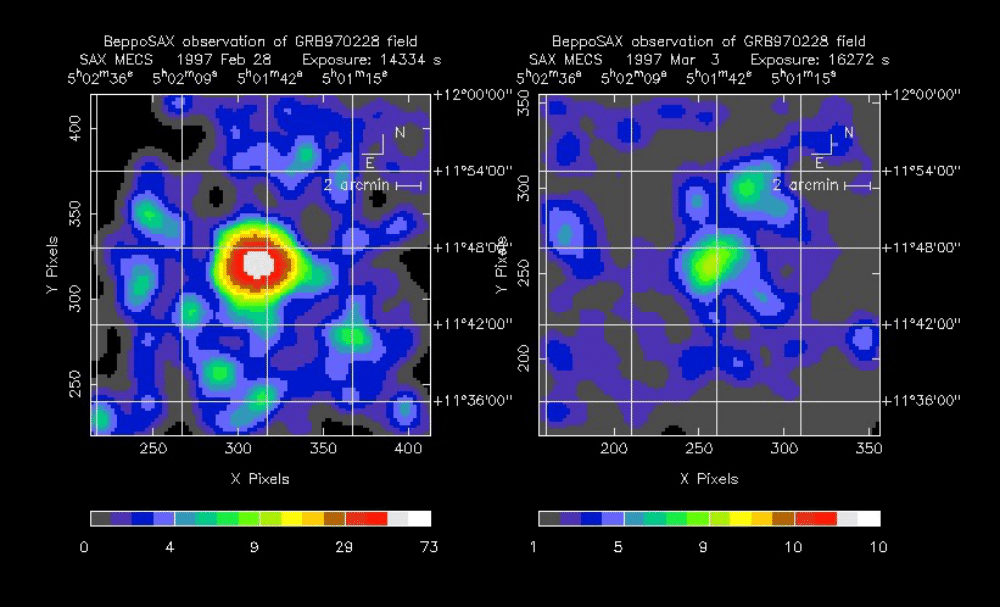
Primo afterglow X
Il 2022 e’ anche il 25ennale della prima osservazione di un afterglow di GRB fatta con BeppoSAX prima nei raggi X e poi con i telescopi di La Palma, e pure di Campo Imperatore in ottico. Questo ha portato alla localizzazione accurata delle galassie ospiti e alla conseguente osservazione spettroscopica che ha determinato che le distanze dei GRB erano cosmologiche.
Bibliografia: https://www.nature.com/articles/42885CCD images of the field of GRB970228 taken at the 0.60 m Schmidt telescope at Campo Imperatore.
The numbers indicate the reference stars, used to set the photometry zero point.
The centers of the circles indicate the location of the Optical Transient (labelled OT) and of the KM star (labelled S).
Each image covers a field of ≈ 2.8 × 1.9 arcmin2 . North and East are top and left, respectively.
Bibliografia: https://www.nature.com/articles/386686a0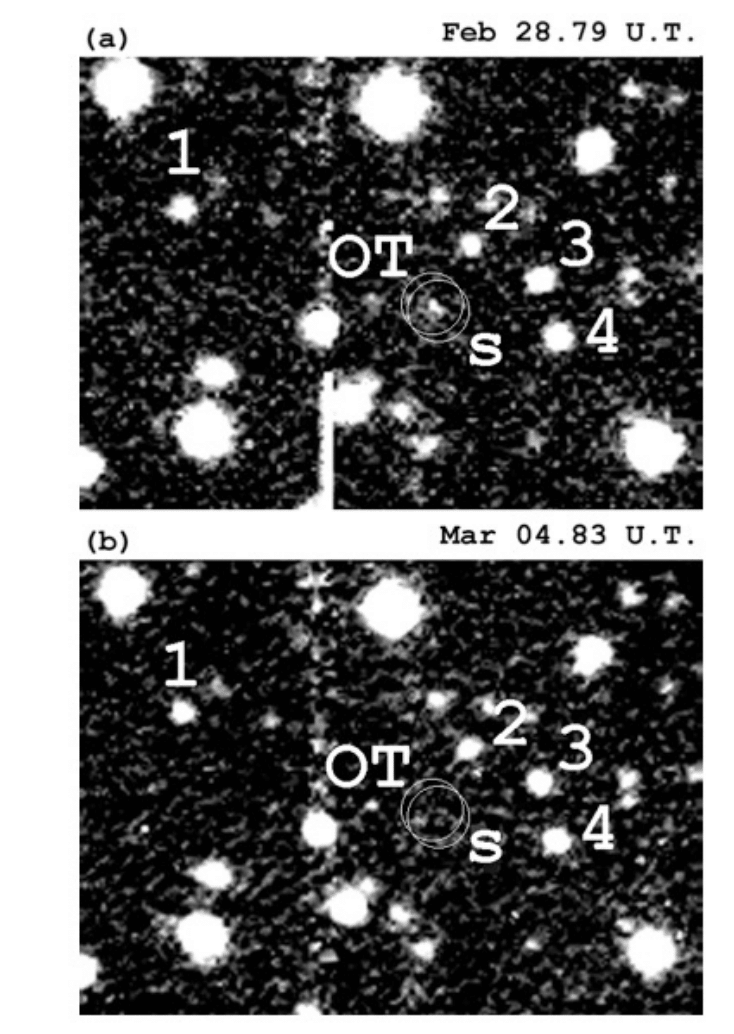
afterglow ottico Campo Imperatore
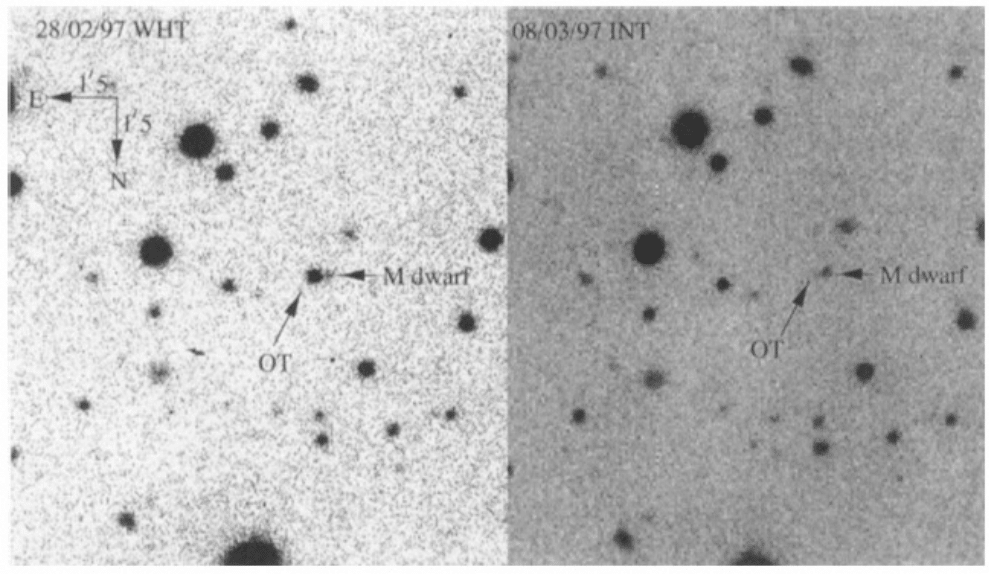
afterglow ottico dal WHT
V-band images of a 1.5' x 1.5' region of the sky containing the position of the opticatl transient. The left image was obtained with the WHT on 1997 28th of Febrauary, UT 23h 48min, the right image with the INT on March, UT 20h 42min.
The optical transient is indicated by 'OT'. The 'M' dwarf, separeted from the optical transient by 2.9", is also indicated. Bibliografia: https://arxiv.org/pdf/astro-ph/9709105.pdf
AGENDA
Programma delle giornate
12/09/22
14:30 - 14:50
INTRODUCTION
14:50 - 15:20
Lorenzo AmatiThe Amati relation after 20years: discovery, main properties, most relevant applications and perspectives
15:20 - 15:50
Gor OganesyanPhysics of the GRB prompt emission
15:50 - 16:10
Maria Edvige RavasioNew insights into the physics of GRB prompt emission from high energy observations
16:10 - 16:30
OPEN DISCUSSION
16:30 - 17:00
COFFEE BREAK
17:00 - 17:20
Martin TopinkaIs rapid optical rise of GRB 190919B a sign of late flaring activity
17:20 - 17:40
Riccardo BrivioGRB 080928 afterglow polarization analysis and GRB afterglow spectropolarimetry
17:40 - 18:00
Stefano GiarratanaGRB 201015A: a relatively faint GRB with a hint of Very High Energy gamma-ray emission
18:00 - 18:20
Marco MarongiuRadio data challenge the broadband modelling of GRB160131A afterglow
18:20 - 18:30
OPEN DISCUSSION
13/09/22
9:00 - 9:30
Francesco LongoHigh Energy emission from GRBs, from Fermi to IACTs
9:30 - 10:00
Lara NavaGamma-Ray Bursts at the highest energies
10:00 - 10:20
Davide MiceliVery high energy emission from gamma-ray bursts with the MAGIC telescopes
10:20 - 10:40
Alessio MeiGeV emission from a compact binary merger
10:40 - 10:50
OPEN DISCUSSION
10:50 - 11:20
COFFEE BREAK
11:20 - 11:50
Paolo D'AvanzoShort Gamma-ray bursts in the multi-messenger era: situation and perspectives
11:50 - 12:20
Riccardo CiolfiFrom binary neutron star mergers to short gamma-ray burst jets: towards the first end-to-end numerical modelling
12:20 - 12:40
Giulia GianfagnaA simultaneous model fitting of GW and EM data of mergers: breaking model degeneracies in GW170817 and future events
12:40 - 13:00
Matteo FerroSearch for afterglow and kilonova emission in short GRBs
13:00 - 15:00
LUNCH BREAK
15:00 - 15:20
Luca IzzoThe first orphan GRB detected through its associated SN emission
15:20 - 15:40
Anna Elisa CamisascaOptimising the observation strategy of optical counterparts to short GRBs with robotic Liverpool Telescope
15:40 - 16:10
Samuele RonchiniPerspectives for multi-messenger astronomy with the next generation of gravitational-wave detectors and high-energy satellites
16:10 - 16:30
OPEN DISCUSSION
16:30 - 17:00
COFFEE BREAK
17:00 - 18:30
SPECIAL TALK
Enrico Costa, Filippo Frontera, Luigi Piro
Story of a discovery 25 years later: the GRB afterglow with BeppoSAX
20:30 - 23:00
CENA SOCIALE alla "Bottega di Trimalcione"
14/09/22
9:20 - 9:50
Giancarlo GhirlandaThe structure of Gamma Ray Burst jets
9:50 - 10:20
Stefano AscenziThe origin of the X-ray plateaus in the structured jet scenario
10:20 - 10:50
Maria Grazia BernardiniGamma-Ray Bursts central engine in the multi-messenger era
10:50 - 11:20
COFFEE BREAK
11:20 - 11:50
Simone Dall'OssoThe hunt for GRB central engines
11:50 - 12:10
OPEN DISCUSSION
12:10 - 12:40
Jorge RuedaWhite dwarf binary mergers: an overlooked class of low-energy gamma- ray bursts
12:40 - 13:00
Andrea RossiMixing up the standard GRB classification
13:00 - 15:00
LUNCH BREAK
15:00 - 15:20
Riccardo CrupiA data driven framework for searching long faint astronomical high- energy transients
15:20 - 15:50
Andrea RossiThe hunt for GRB host galaxies
15:50 - 16:10
Lorenzo CavalloOn the hosts of neutron star mergers in the nearby Universe
16:10 - 16:30
Andrea SaccardiDissecting the ISM of a z=6.3 galaxy. X-shooter spectroscopy and HST imaging of the afterglow and environment of the Swift GRB 210905A
16:30 - 17:00
COFFEE BREAK
17:00 - 17:20
OPEN DISCUSSION
17:20 - 17:50
Dafne GuettaOn the hadronic origin of the TeV radiation from GRBs and the expected neutrino flux
17:50 - 18:10
Graziella PizzichiniI shall report on an ongoing search for particular properties of GRBs at high redshift
15/09/22
9:00 - 9:20
Alfredo LuminariTime Evolving Photoionisation Device (TEPID): a new code for time evolving photoionisation and spectral fitting
9:20 - 9:40
Aishwarya Linesh ThakurTime-evolving modelling for fits to Xray GRB afterglows
9:40 - 10:00
Maria Grazia BernardiniThe SVOM mission
10:00 - 10:40
Giulia StrattaThe Transient High-Energy Sky and Early Universe Surveyor (THESEUS)
10:40 - 10:50
OPEN DISCUSSION
10:50 - 11:20
COFFEE BREAK
11:20 - 11:40
Ezequiel MarchesiniThe X/Gamma-ray Imaging Spectrometer XGIS: Unveiling a high- energy broadband
11:40 - 12:00
Giuseppe DililloAlgorithms for Gamma-Ray Bursts detection
12:00 - 12:20
Giovanni Della CasaStudy of Gamma-Ray Bursts microvariability
12:20 - 12:40
Fabrizio FioreHERMES and SpIRIT status report
12:40 - 13:00
OPEN DISCUSSION
13:00 - 15:00
LUNCH BREAK
15:00 - 15:20
Riccardo CampanaHERMES and SpIRIT payload calibration
15:20 - 15:40
Andrea SannaOn the localisation capabilities of the HERMES + SpIRIT constellation of cube-sats
15:40 - 16:00
Lara Nava-Giancarlo GhirlandaHERMES detection rate and synergies with GW interferometers
16:00 - 16:20
Luciano BurderiALBATROS
16:20 - 16:40
CONCLUDING REMARKS
Mancano ancora
days
SPEAKERS
Invited Speakers


Maria Grazia Bernardini
INAF-Osservatorio Astronomico di Brera
Gamma-Ray Bursts central engine in the multi-messenger era.
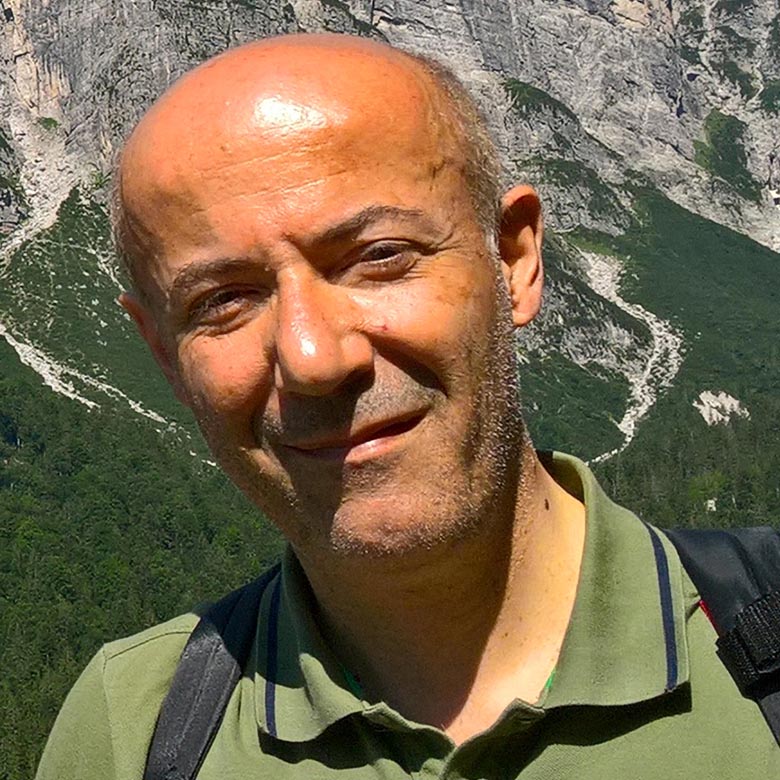
Lorenzo Amati
INAF-OAS Bologna
The Amati relation after 20years: discovery, main properties, most relevant applications and perspectives.

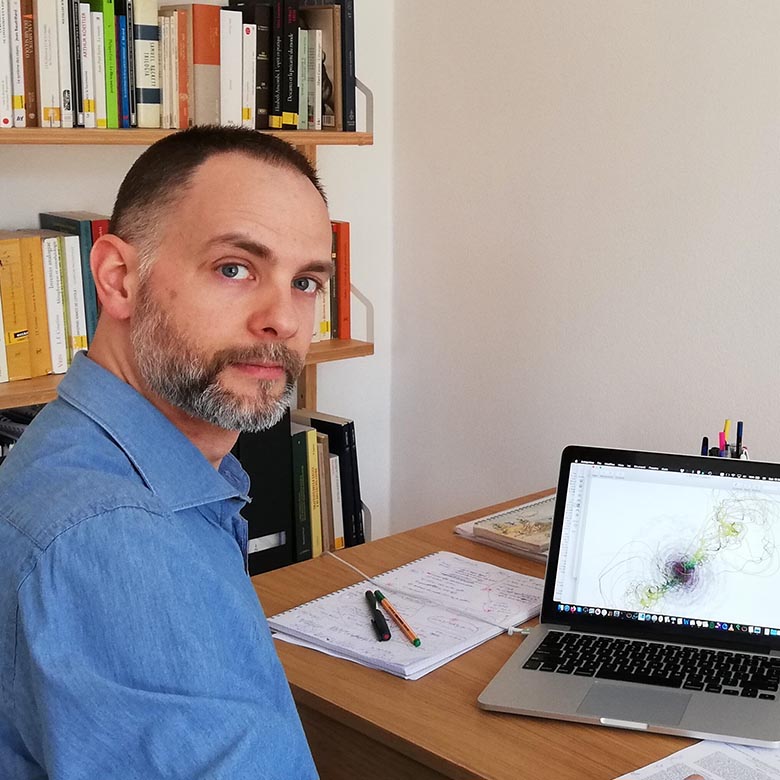
Riccardo Ciolfi
INAF, Osservatorio Astronomico di Padova
From binary neutron star mergers to short gamma-ray burst jets: towards the first end-to-end numerical modelling.


Jorge Armando Rueda Hernandez
ICRANet,Ferrara
White dwarf binary mergers: an overlooked class of low-energy gamma-ray bursts.
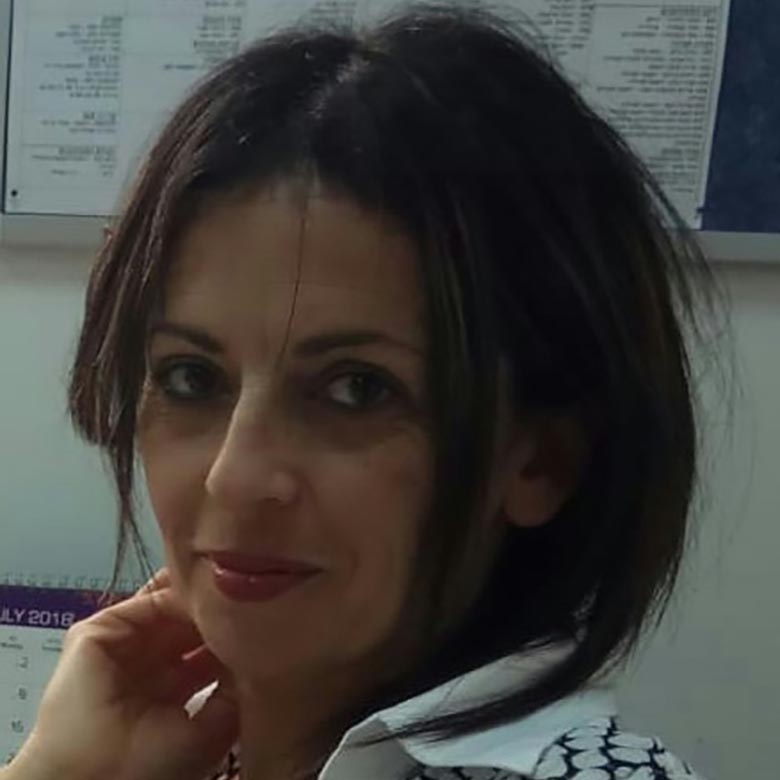
Dafne Guetta
Ariel University, Ariel, Israel
On the hadronic origin of the TeV radiation from GRBs and the expected neutrino flux.

Paolo D'Avanzo
INAF-OAB
Short Gamma-ray bursts in the multi-messenger era: situation and perspectives.

Samuele Ronchini
Gran Sasso Science Institute
Perspectives for multi-messenger astronomy with the next generation of gravitational-wave detectors and high-energy satellites.
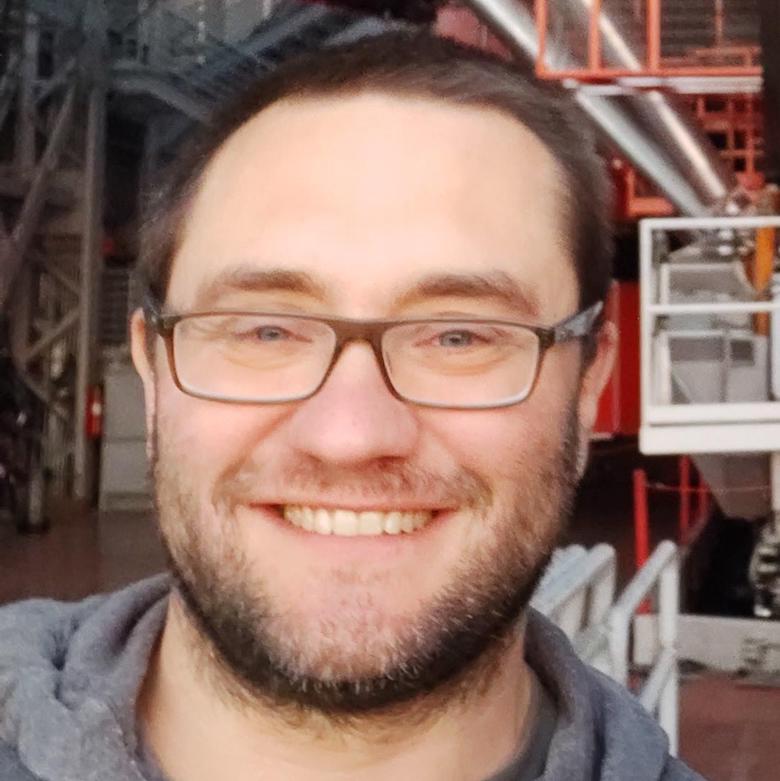


Stefano Ascenzi
Institute of Space Sciences (ICE)-CSIC-IEEC
The origin of the X-ray plateaus in the structured jet scenario.
F. Fiore, L. Nava, F. Longo, A. Celotti, L. Amati, L. Piro, M. Branchesi, M. Della Valle, G. Ghisellini, A. Sanna, G. Tagliaferri, A. Vacchi, S. Savaglio
F. Fiore, L. Nava, A. Celotti, C. Feruglio, F. Longo, M. Citossi, G. Dilillo, G. Della Casa, G. Principe, I. Burelli, A. Vigliano, G. Ardizzoia

Registration form
Registration to the Conference
The registration fee is 180 EUR, which includes lunches, coffee breaks and social dinner for the whole duration of the conference.
GRBV Conference is supported by CIFS – Consorzio Interuniversitario per la Fisica Spaziale.
The registration is closed.
CONTACT
Any question? please feel free to contact us at grbv@inaf.it
VENUE
IFPU (Institute for Fundamental Physics of the Universe) - Aula Magna (Former SISSA Building)
Miramarevia Beirut, 2
34151 Trieste-Italy
How to reach us


